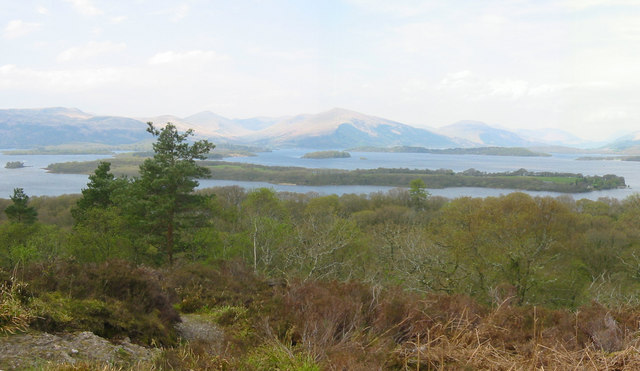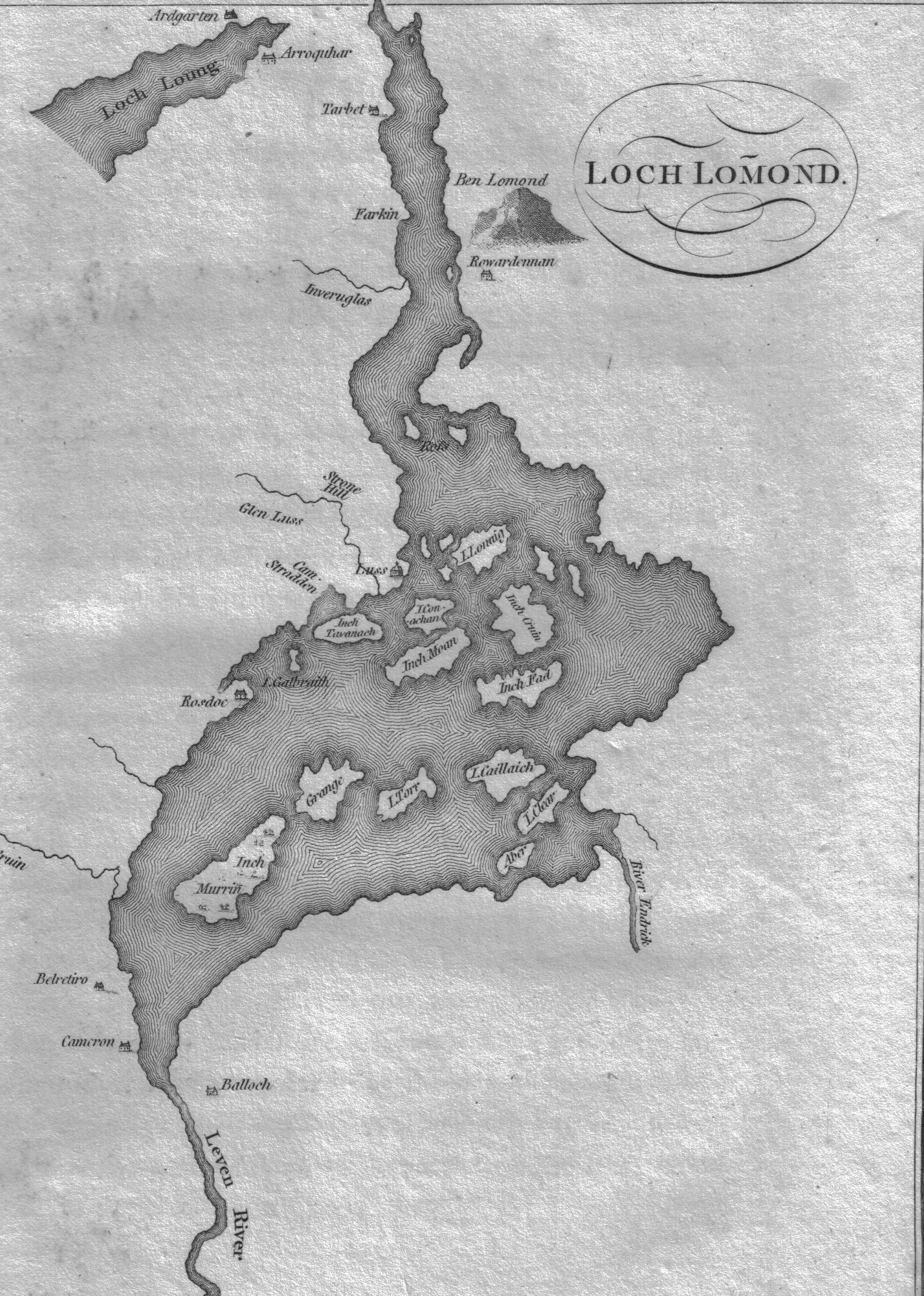Inchcailloch on:
[Wikipedia]
[Google]
[Amazon]
 Inchcailloch ( gd, Innis na Cailleach) is an
Inchcailloch ( gd, Innis na Cailleach) is an
 Inchcailloch has been used as a hunting forest since the reign of
Inchcailloch has been used as a hunting forest since the reign of
article which mentions it
{{coord, 56, 04, 52, N, 4, 33, 21, W, display=title, region:GB_type:isle_source:GNS-enwiki Cailloch Highland Boundary Fault Uninhabited islands of Stirling (council area) Protected areas of Stirling (council area) Loch Lomond National Nature Reserve
 Inchcailloch ( gd, Innis na Cailleach) is an
Inchcailloch ( gd, Innis na Cailleach) is an islet
An islet is a very small, often unnamed island. Most definitions are not precise, but some suggest that an islet has little or no vegetation and cannot support human habitation. It may be made of rock, sand and/or hard coral; may be permanent ...
on Loch Lomond
Loch Lomond (; gd, Loch Laomainn - 'Lake of the Elms'Richens, R. J. (1984) ''Elm'', Cambridge University Press.) is a freshwater Scottish loch which crosses the Highland Boundary Fault, often considered the boundary between the lowlands of Ce ...
in Scotland. It is at its highest point. It is also known to some as Inchebroida.
The name Inchcailloch means "Isle of the old woman" or "Isle of the Cowled (Hooded) Woman" in the Scottish Gaelic
Scottish Gaelic ( gd, Gàidhlig ), also known as Scots Gaelic and Gaelic, is a Goidelic language (in the Celtic branch of the Indo-European language family) native to the Gaels of Scotland. As a Goidelic language, Scottish Gaelic, as well as ...
language. Saint Kentigerna went to Scotland from Ireland to preach and spread Christianity and the island is thought to be named after her.
Geography and geology
Inchmurrin
Inchmurrin ( gd, Innis Mhearain) is an island in Loch Lomond in Scotland. It is the largest fresh water island in the British Isles.
Geography and geology
Inchmurrin is the largest and most southerly of the islands in Loch Lomond. It reache ...
, Creinch
Creinch ( gd, Craobh-Innis, Tree Island) is an island on the Highland Boundary Fault in Loch Lomond.
History
Formerly Inchcroin (not to be confused with Inchcruin), Creinch lies a little north of Inchmurrin.Wilson, Rev. John ''The Gazetteer of ...
, Torrinch
Torrinch or Inchtore ( gd, Torr-Innis) is a wooded island in Loch Lomond in Scotland. The name Torremach is also recorded for it.Wilson, Rev. John ''The Gazetteer of Scotland'' (Edinburgh, 1882) Published by W. & A.K. Johnstone
Geography
It is ...
, and Inchcailloch all form part of the Highland boundary fault
The Highland Boundary Fault is a major fault zone that traverses Scotland from Arran and Helensburgh on the west coast to Stonehaven in the east. It separates two different geological terranes which give rise to two distinct physiographic terr ...
.
There is a burial ground in the north of the island, and a bay, Port Bawn ( gd, Port Bàn; en, White Port), in the south.
Like many of the Loch Lomond islands, it is quite heavily wooded.
Transport
There is a passenger ferry across the short channel separating it fromBalmaha
Balmaha (Gaelic: ''Baile Mo Thatha'') is a village on the eastern shore of Loch Lomond in the council area of Stirling, Scotland.
The village is a popular tourist destination for picnickers and day trippers from Glasgow as well as walkers on ...
on the mainland. As a result, it receives more visitors than most of the Loch Lomond islands, currently 20,000 visitors per year. There is a camp site in the south at Port Bawn and a nature trail.
History
 Inchcailloch has been used as a hunting forest since the reign of
Inchcailloch has been used as a hunting forest since the reign of Robert the Bruce
Robert I (11 July 1274 – 7 June 1329), popularly known as Robert the Bruce (Scottish Gaelic: ''Raibeart an Bruis''), was King of Scots from 1306 to his death in 1329. One of the most renowned warriors of his generation, Robert eventual ...
. Deer still roam the island. White deer have been seen on the island in 2003. The narrow crossing is very shallow making an easy passage for deer to ford. The island was farmed until the early 19th century, being recorded in 1800 as producing good wheat and oats; the ruins of the farm can still be seen. For around 130 years, Inchcailloch was an oak plantation. The resulting timber was processed at Balmaha
Balmaha (Gaelic: ''Baile Mo Thatha'') is a village on the eastern shore of Loch Lomond in the council area of Stirling, Scotland.
The village is a popular tourist destination for picnickers and day trippers from Glasgow as well as walkers on ...
(on the site of the Highland Way Inn), for making wood vinegar (pyroligneous acid
Pyroligneous acid, also called wood vinegar or wood acid, is a dark liquid produced by the destructive distillation of wood and other plant material Composition
The principal components of pyroligneous acid are 10% acetic acid, acetone and metha ...
), wood tar, and dye.
Inchcailloch had a church dedicated to St Kentigerna, which was the parish church until 1621, but the graveyard was used until 1947. St Kentigerna was an Irish woman who is not to be confused with St Kentigern (a man who is also known as St Mungo
Kentigern ( cy, Cyndeyrn Garthwys; la, Kentigernus), known as Mungo, was a missionary in the Celtic Britons, Brittonic Kingdom of Strathclyde in the late sixth century, and the founder and patron saint of the city of Glasgow.
Name
In Wales and ...
). The Clan MacGregor
Clan Gregor, also known as Clan MacGregor, () is a Highland Scottish clan that claims an origin in the early 9th century. The clan's most famous member is Rob Roy MacGregor of the late 17th and early 18th centuries. The Clan is also known to hav ...
burial ground includes some of Rob Roy's ancestors. Legends have passed by word of mouth that the bones of a woman were found under the altar stone during an excavation.
Inchcailloch forms part of Loch Lomond National Nature Reserve
Loch Lomond National Nature Reserve (NNR) ( gd, Tèarmann Nàdair Nàiseanta Loch Laomainn) encompasses 430 hectares of land at the southeastern part of Loch Lomond in the council areas of Stirling and West Dunbartonshire, in Scotland. It co ...
, owned and run by Scottish Natural Heritage
NatureScot ( gd, NàdarAlba), which was formerly known as Scottish Natural Heritage, is an executive non-departmental public body of the Scottish Government responsible for the country's natural heritage, especially its natural, genetic and ...
.
Literary references
Inchcailloch is mentioned in Dr William Fraser's ''The Lennox'' (1874). The travel writer, H.V. Morton visited in the 1930s, and remarked: :''The isle is sacred to the MacGregors, and in the tangled branches and amongst the green trees is their ancient burial ground. It was on the halidom of him 'who sleeps beneath the grey stone of Inchcailloch' that members of this vigorous clan used to take their oaths.''Walter Scott
Sir Walter Scott, 1st Baronet (15 August 1771 – 21 September 1832), was a Scottish novelist, poet, playwright and historian. Many of his works remain classics of European and Scottish literature, notably the novels ''Ivanhoe'', ''Rob Roy (n ...
refers to the island in his poem, ''The Lady of the Lake
The Lady of the Lake (french: Dame du Lac, Demoiselle du Lac, cy, Arglwyddes y Llyn, kw, Arloedhes an Lynn, br, Itron al Lenn, it, Dama del Lago) is a name or a title used by several either fairy or fairy-like but human enchantresses in the ...
'' -
:A slender crosslet formed with care
:A cubit's length in measure due
:The shafts and limbs were rods of yew
:Whose parents in Inch Cailliach wave
:Their Shadows o'er Clan Alpine's grave,
:And, answering Lomond's breezes deep,
:Soothe many a chieftain's endless sleep.
See also
*List of islands of Scotland
This is a list of islands of Scotland, the mainland of which is part of the island of Great Britain. Also included are various other related tables and lists. The definition of an offshore island used in this list is "land that is surrounded by ...
References
External links
* https://web.archive.org/web/20090710015304/http://lochlomond-islands.com/article which mentions it
{{coord, 56, 04, 52, N, 4, 33, 21, W, display=title, region:GB_type:isle_source:GNS-enwiki Cailloch Highland Boundary Fault Uninhabited islands of Stirling (council area) Protected areas of Stirling (council area) Loch Lomond National Nature Reserve